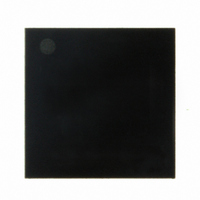TRC103 RFM, TRC103 Datasheet - Page 45

TRC103
Manufacturer Part Number
TRC103
Description
RFIC TRANSCEIVER MULTI-CHANNEL F
Manufacturer
RFM
Series
TRCr
Datasheet
1.TRC103.pdf
(64 pages)
Specifications of TRC103
Frequency
863MHz ~ 960MHz
Data Rate - Maximum
100kbps
Modulation Or Protocol
FSK, OOK
Applications
General Purpose
Power - Output
11dBm
Sensitivity
-112dBm
Voltage - Supply
2.1 V ~ 3.6 V
Current - Receiving
4mA
Current - Transmitting
30mA
Data Interface
PCB, Surface Mount
Antenna Connector
PCB, Surface Mount
Operating Temperature
-40°C ~ 85°C
Package / Case
32-QFN
Lead Free Status / RoHS Status
Lead free / RoHS Compliant
Memory Size
-
Other names
583-1095-2
The minimum required deviation for good TRC103 FSK performance is:
Where F
mended deviation is ±33 kHz, even at low data rates. F
the standard crystal frequency of 12.8 MHz:
Where F
R must be an integer value, so F
is not an integer for your desired deviation, round the value of R down to the nearest integer and use this value to
meet or exceed the minimum required deviation for the bit rate you are using.
Once BR and F
can be determined. The recommended 3 dB bandwidth (cutoff frequency) for the transmitter anti-aliasing filters is:
Where F
kHz and BR is the bit rate in kb/s. F
standard crystal frequency of 12.8 MHz:
Where F
tern in TXCFG1A bits 7..4, and F is the integer value of the bit pattern in RXCFG13, which has a default value of
7. Assuming this default value of F is used, the equation for determining K is:
K must be an integer value, so F
not an integer for your desired deviation, round the value of K down to the nearest integer and use this value to
set the bandwidth of the transmitter anti-aliasing filters. For operation at 90 kb/s and above, use a value of 15
for K.
The recommended 3 dB bandwidth for the receiver Butterworth filters is:
Where F
is the bit rate in kb/s. This equation assumes use of the high accuracy, low drift XTL1020P crystal. If an alterna-
tive crystal is used, add ½ the expected drift due to temperature and aging to the equation above. F
ured with bits 3..0 in RXCFG10 and the byte in RXCFG13. For the standard crystal frequency of 12.8 MHz:
Where F
in RXCFG10 bits 3..0, and F is the integer value of the bit pattern in RXCFG13, which has a default value of 7.
Assuming this default value of F is used, the equation for determining J is:
www.RFM.com
©2009-2010 by RF Monolithics, Inc.
F
F
R = (12800 - 32*F
F
F
K = (F
F
F
J = (F
DEV
DEV
CTX
CTX
CBW
CBW
DEV
DEV
CTX
CTX
CBW
CBW
is the deviation in kHz and BR is the bit rate in kb/s. Specific to the TRC103, the minimum recom-
is the deviation in kHz. Solving the equation above for R:
is the 3 dB bandwidth of the transmitter anti-aliasing filters in kHz, F
is the 3 dB bandwidth of the transmitter anti-aliasing filters in kHz, K is the integer value of the bit pat-
is the 3 dB bandwidth of the Butterworth filters in kHz, F
is the 3 dB bandwidth of the receiver Butterworth filters in kHz, J is the integer value of the bit pattern
= 3*F
= 200*(K + 1)/(F+1), with K in the range of 0 to 15
= BR
= 12800/(32*(R + 1)), with the useable range of R 1 to 11
E-mail:
= 2*F
= 200*(J + 1)/(F+1), with J in the range of 0 to 15
CBW
CTX
DEV
- 25)/25
- 25)/25
DEV
DEV
have been determined, the bandwidths and related configuration values for the TRC103 filters
info@rfm.com
+ 1.5*BR
+ BR
DEV
)/32*F
CTX
DEV
DEV
CTX
is limited to 16 discrete values. If the value of K given in the above equation is
is limited to 11 discrete values. If the value of R given in the above equation
is configured with bits 7..4 in TXCFG1A and the byte in RXCFG13. For the
Technical support +1.800.704.6079
DEV
is configured with an integer R stored in MCFG02. For
DEV
is the frequency deviation in kHz and BR
DEV
is the frequency deviation in
TRC103 - 12/15/10
CBW
Page 45 of 64
is config-

















